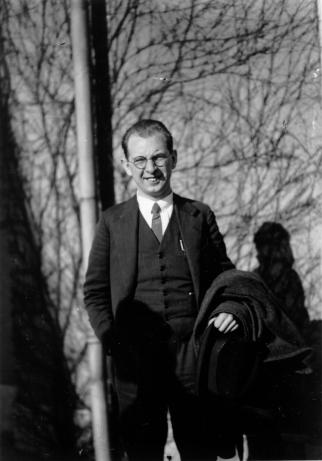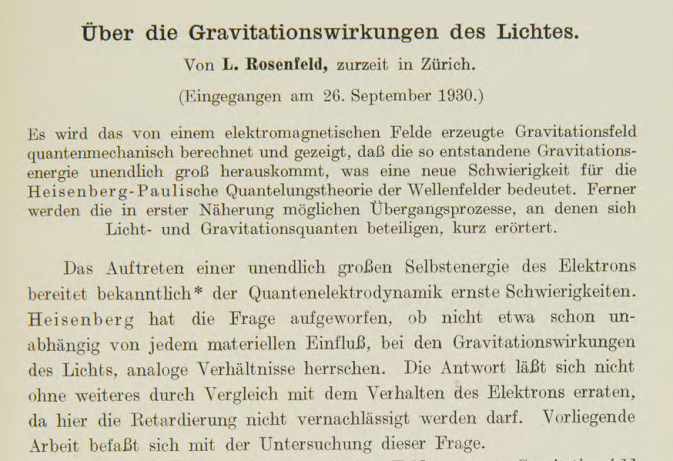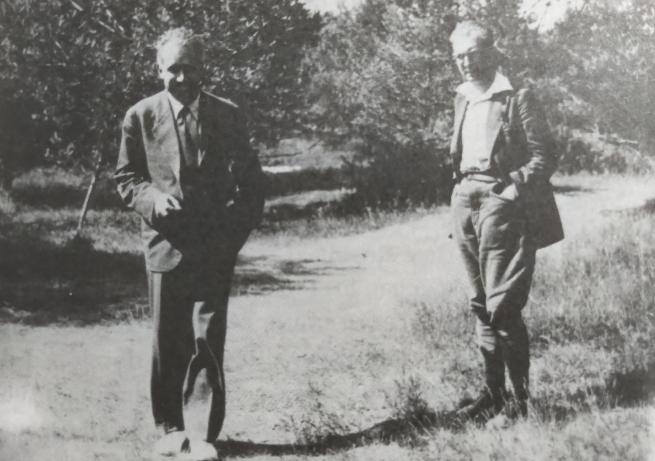There are also historical cases of this kind, such as Albert Einstein's unified field theory and John Wheeler’s geometrodynamics. Using such cases, the research project "The Role of Mathematics in the Final Theory Program" aims at an historical understanding of how mathematical methodologies, as opposed to traditional physical methodologies, came to be deployed in twentieth-century theoretical physics to put into practice dreams of final theories and unification, and set the course for foundational physics as is practiced today.

Léon Rosenfeld portrait photograph, 1931. Source: Niels Bohr Archive.
Looking at an Origin of Quantum Gravity
A first instructive historical case is the work of Léon Rosenfeld, a Belgian theoretical physicist who is probably best known for having been a close collaborator of Danish physicist Niels Bohr, and for having fiercely defended his interpretation of quantum mechanics. But before Rosenfeld started working with Bohr in 1931, he was in fact the first person to ever attempt a quantum mechanical description ("quantization") of the gravitational field in the modern sense. Originally, quantum and gravitational effects had theoretically and phenomenologically been treated distinctly from each other. While quantum mechanics describes the—at the time still fairly newly-discovered-—quantum properties of the microscopic world, general relativity describes the workings of gravity in a large-scale, geometric manner. But the empirical necessity to also treat the electromagnetic force-field in quantum mechanical terms, and the work on formal expressions of it—most importantly on a framework called quantum field theory—also opened the gates for theoretical speculations about the necessity and feasibility of a quantization of the gravitational field.
Rosenfeld now developed methods to formally treat such a quantization, for both the full gravitational field and for linear approximations of it. Curiously, however, right after having groundbreakingly pioneered in this field, Rosenfeld would completely turn his back against this work. For the rest of his life, he would argue against the physical meaningfulness and necessity of the quantization of the gravitational field altogether. In his lecture notes on quantum field theory from 1932, Rosenfeld claimed:
"The first successes of the theory of quantization of the radiation field made it possible to suppose for a moment that within the framework of quantum mechanics, this method provided a rigorous mathematical expression of the correspondence principle. But in reality ... the new formalism can only be conceived as a symbolic computational procedure."
The correspondence principle, which relates the quantum and the classical description of a physical system, thus has, from Rosenfeld's point of view, a meaning only for systems that are of experimentally-proven quantum mechanical nature. The principle in itself does not have any inherent predictive power, and thus mathematical methods that codify it in one way or another cannot be trusted to reveal and describe a hypothetical quantum mechanical nature of a classical physical system, such as the gravitational field. The application of any such method can consequently only be regarded as an act of mathematics, rather than of physics.

Detail of the front page of an article by Rosenfeld on the quantization of gravity, 1930. In: Alexander S. Blum and Dean Rickles (eds.): Quantum Gravity in the First Half of the Twentieth Century: A Sourcebook. Online version at https://edition-open-sources.org/sources/10/
view full article here
Placing Experience over Ideas and Formalism
But what were the factors that influenced Rosenfeld's drastic reconsideration of this matter? His work on the quantization of gravitation has been groundbreaking, without a doubt. But it was not entirely successful: Rosenfeld was unable to finish with a complete quantization of the gravitational field. It is thus plausible to assume that Rosenfeld was susceptible to the kinds of ideas that would provide an explanation for this failure. And it is probably this state of mind with which Rosenfeld arrived in Copenhagen to work with Bohr, where he witnessed a practice of physics that, quite in contrast to his own methodology until that point, placed experience over formalism.
At the same time, this practice of Bohr's resonated strongly with Rosenfeld’s take on dialectic materialism, a philosophical attitude concerning the methodology of science originating in Marxist philosophy. In his famous but controversial 1953 article "The Strife about Complementarity," Rosenfeld described materialism "in contrast to idealism" as regarding "the formation of our ideas and concepts as the result of a process of gradual adaptation of mind to experience." Thus, from the point of materialism, "ideas are not at the origin but at the end of this process." Rosenfeld therefore concluded that putting ideas first, that is, imagining "that it is our mind which impresses its sovereign stamp on the phenomena," is bound to deal with formalistic aspects of theories.
This intensified engagement with dialectic materialism in interaction with his collaboration with Bohr, in whose work Rosenfeld saw these ideas as being put into practice, could well have served as a natural and welcome framework with which to provide an explanation for the shortcomings of his research on the quantization of the gravitational force field.

Left to right: Niels Bohr, Wolfgang Pauli (back), Lothar Nordheim, Erwin Fues, and Léon Rosenfeld conversing (cropped), 1929. Source: Niels Bohr Archive.
Unification as a Driver for Mathematization?
The relevance of this historical case study, however, exceeds the mere clarification of Rosenfeld's change of attitude in this matter. It also provides evidence that neither the application of mathematical methodologies in final or unifying theoretical attempts, nor the criticism thereof, is a mere modern phenomenon. It was already being practiced and identified in the very early days of quantum field theory.
But why has the development and application of such formal, non-empirically-founded methods not lost its momentum? This is especially worth considering given that such methods do not seem to have brought about final theories that are in accordance with experience, the latter being otherwise a fundamental aim of physics. Arguing with Rosenfeld’s reasoning against idealism, it would be the programmatic motive of unification itself that needs to be held responsible for the production of such methods. However, only the investigation of further historical cases that evidence mathematical practices to gain physical insight will be able to tell us whether or not this is a legitimate claim.

Niels Bohr and Léon Rosenfeld near Bohr's summer house at Tisvilde, Denmark, 1931. Source: Niels Bohr Archive.
